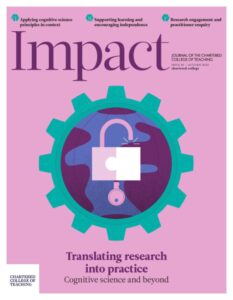Revision techniques: What are the best options for students’ learning?
Written by: George Davies-Craine

6 min read
George Davies-Craine, Subject Leader for Geography and Digital Learning Lead, Dr Challoner’s Grammar School, UK
Learning and revision: An introduction
Cognitive science has shown that regular testing of students’ knowledge is one of the most effective methods of learning and revising material for assessments (Dehaene, 2020; Dunlosky et al., 2015). While the process of revising is retrieving information from memory and checking understanding (Jones, 2019), there is a variety of alternative revision techniques for students, such as summarising and mnemonics, yet only some support deep, long-term learning and understanding of material.
Brown et al. (2014) argue that learning information requires not only for it to be recalled, but also for it to be understood in relation to other information. Dehane argues that ‘learn[ing] is to form an internal model of the external world’ (2020, p. 5); over time, we adjust our internal model in relation to new information, reducing the numb
Join us or sign in now to view the rest of this page
You're viewing this site as a guest, which only allows you to view a limited amount of content.
To view this page and get access to all our resources, join the Chartered College of Teaching (it's free for trainee teachers and half price for ECTs) or log in if you're already a member.
- Bjork RA and Bjork EL (1992) A new theory of disuse and an old theory of stimulus fluctuation. In: Healy AF, Kosslyn SM and Shiffrin RM (eds) From Learning Processes to Cognitive Processes: Essays in Honor of William K Estes, vol 2. Hove and London: Lawrence Erlbaum Associates, pp. 35–67.
- Brown PC, Roediger (III) HL and McDaniel MA (2014) Make it Stick: The Science of Successful Learning. London: TJ Books.
- Butterfield B and Metcalfe J (2001) Errors committed with high confidence are hyper corrected. Journal of Experimental Psychology: Learning, Memory, and Cognition 27: 1491–1494.
- Carey B (2012) How We Learn. London: Macmillan.
- Conway M, Cohen G and Stanhope N (1991) On the very long-term retention of knowledge acquired through formal education: Twelve years of cognitive psychology. Journal of Experimental Psychology: General 120(4): 395–409.
- Dehaene S (2020) How We Learn: The New Science of Education and the Brain. London: Penguin.
- Dunlosky J, Rawson KA, Marsh EJ et al. (2015) What works, what doesn’t. Scientific American Mind 24(4): 46–53.
- Hausmann R (2020) Cognitive Science for Educators. Florida: John Catt Educational.
- Jones K (2019) Retrieval Practice. Woodbridge: John Catt Educational.
- Mitchell J (2016) 100 Ideas for Secondary Teachers: Revision. London: Bloomsbury.
- Weinstein Y, Sumeracki M and Caviglioli O (2019) Understanding How We Learn. Abingdon: Routledge.
5
1
vote
Please Rate this content
Please login to comment
0 Comments
Oldest
Newest
Most Voted
Inline Feedbacks
View all comments










